The Effect of Reflexology Therapy on a Patient Suffering from Tremor Syndrome
by Yonatan Crispel1,2*, Nofar Gordon2, Miriam Sela2
1Department of Hematology, Thrombosis and Hemostasis Unit, Rambam Health Care Campus, Haifa, Israel
2Rappaport Family Faculty of Medicine, Technion, Israel Institute of Technology, Haifa, Israel
*Corresponding author: Yonatan Crispel, Department of Hematology, Hematological Institute, Rambam Health Care Campus, Hospital of Haifa, Haifa, Israel Rambam Medical Center, POB 9602, Haifa 31096, Israel
Received Date: 04 September 2025
Accepted Date: 09 September 2025
Published Date: 11 September 2025
Citation: Crispel Y, Gordon N, Sela M. (2025). The Effect of Reflexology Therapy on a Patient Suffering from Tremor Syndrome. Ann Case Report. 10: 2405. DOI:10.29011/2574-7754.102405
Abstract
Background: Reflexology is one of the oldest, most well-known and proven treatment methods in the field of complementary medicine. In this case, reflexology was used to reduce the number of vibrations in a patient suffering from tremor syndrome. Methods: This study was conducted over a period of nine months, with sessions held once a week. The patient followed a test protocol in which she recorded the number of tremors in the morning, afternoon and evening at fixed times every day of the week, both before and after treatment. Results: A significant improvement in tremors was observed between the start and end of the treatment period (p<0.005, SD = 0.29). Conclusions: The results were significant, showing optimal improvement in the tremors and the patient’s overall condition. Additionally, an improvement in motor function was observed. In conclusion, reflexology can improve tremors without the need for drug treatment.
Keywords: Reflexology Therapy; Tremor Syndrome; Menstrual Mechanotransduction; Aβ Neurons; Retinacula.
Introduction
Reflexology is one of the oldest, most well-known and proven treatment methods in the field of complementary medicine. It is a holistic diagnostic and treatment approach based on the precise mapping and representation of the body’s organs in the feet. Using unique techniques, reflexology promotes flow and movement, encouraging the body to activate its natural healing powers. A wide range of physical and emotional conditions can be addressed through reflexology, including headaches, back pain, irritable bowel syndrome, and support for oncology patients and fertility issues [1].
Background
This study evolved from our previous experience with Parkinson’s patients, who underwent reflexology treatment and showed significant improvement in tremors. However, since these patients were also receiving medication with periodic dosage adjustments, it was not possible to determine whether the improvement in tremors was due to reflexology or the medication, introducing bias into the study results. The current study focuses on a case of tremor syndrome in a young, healthy woman, without any underlying diseases. This allows for a direct examination of the effect of reflexology on tremor syndrome.
Case Presentation
In this study, we examined the effect of a unique reflexology treatment on a 24-year-old woman who had been experiencing tremors in her hands and body for several years without any underlying diseases. She was generally healthy: imaging studies, including CT and MRI, revealed no pathology in the brain (including myelin white matter), and nerve conduction studies (NCS/EMG) showed no abnormalities. Genetic tests and comprehensive blood tests also did not indicate any background disease. According to the patient, the tremors began mildly about ten years ago and gradually increased idiopathically. Overall, the patient reported feeling well, except that the tremors cause her embarrassment in social situations and among her friends.
Research Objective
The aim of the study is to examine whether reflexology treatments can reduce the number of tremors in a patient suffering from tremor syndrome, and whether the treatment can also improve the patient’s overall condition.
Materials and Methods
This study was conducted over a period of nine months, with sessions held once a week. The patient followed a testing protocol in which she recorded the number of tremors in the morning, afternoon, and evening at regular times each day of the week, both before and after treatment. The treatments were performed at a fixed time and on a fixed day each week in the therapist’s clinic. During the treatment, the patient lay on a treatment bed with her face toward the ceiling, in a dimly lit and pleasant environment. The therapist also discussed the patient’s emotional and mental state using the Gestalt method, referred to as “Reflexology in the Spirit of Gestalt”.
Results
In this study we examined the effect of reflexology therapy on the number of vibrations in a patient with tremor syndrome. The results were significant (p<0.005). The treatment lasted approximately nine months, from March to December 2024.
The number of vibrations: Tremors were measured regularly in the morning, noon, and evening. (Figure 1) shows the average vibrations per minute.
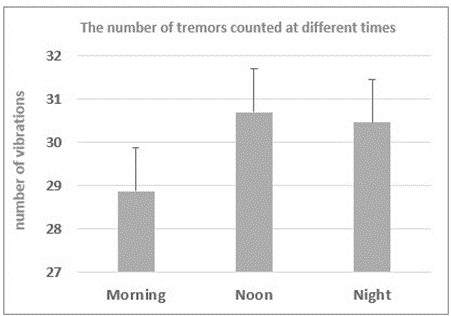
Figure 1: Average vibrations per minute
Day before and day after treatment (March): The illustrations highlight the differences measured in March, the first month of the treatment. (Figure 2) (p = 0.069, NS) shows the comparison of vibrations recorded the day before and the day after treatment.
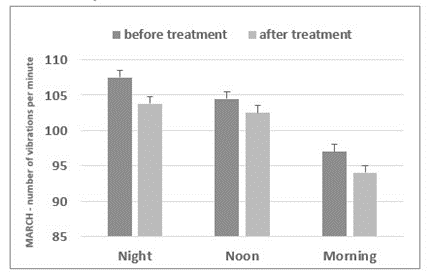
Figure 2: Day before treatment and day after treatment of a patient with tremor syndrome march
Day before and day after treatment (November): (Figure 3) depicts the differences before and after treatment in November, the month before the study concluded. In this case, the results were significant (p< 0.05, SD = 1.48).
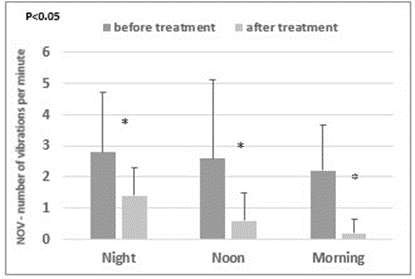
Figure 3: Day before treatment and day after treatment of a patient with tremor syndrome November
Number of vibrations between March and December: (Figure 4) and (Table 1) demonstrate the overall effect of reflexology therapy on tremors, with significantly higher differences observed (p<0.005, SD = 0.29).
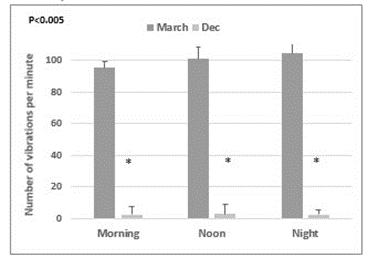
Figure 4: The effect of reflexology therapy on the number of vibrations in a tremor patient between March to December
|
Average Vibration |
March |
December |
|
Morning |
95 |
2 |
|
Noon |
101 |
3 |
|
Night |
104 |
3 |
Table 1: Average vibrations in patient with tremor syndrome
Comparison of the number of tremors: (Figure 5) illustrates the effect of reflexology therapy on the number of vibrations in the patient, as measured regularly in the morning, noon, and evening from March to December.
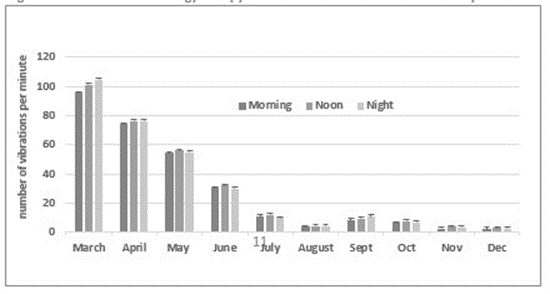
Figure 5: The effect of reflexology therapy on the number of vibrations in a tremor patient
Discussion
In the current study, the results demonstrate that reflexology treatment has a direct effect on the number of tremors in the patient. A decrease in the number of tremors was observed from the first month of treatment, consistently in the morning, afternoon and evening. An exception was noted in September, when treatments were temporarily halted for various reasons. In other months, the patient showed a steady decline in the number of tremors see (Figure 5). The differences between March (start of the study) and December (end of the study) were highly significant. At the beginning of treatment, the patient experienced approximately 100 tremors per minute during each test. By the final month, this number had decreased to just 2-3 tremors per minute see (Table 1). Additionally, a correlation was observed before and after treatment sessions, with the number of tremors drastically decreasing by over 50% within 48 hours see (Figures 2 and 3).
Studies have shown that the retinacula of the ankle and foot are rich in nerve fibers and proprioceptors due to their attachments to bone, muscle, fascial expansions and tendons [2]. Activity in the foot and ankle delivers signals to the brain regarding spatial positioning and effective movement in space, so working on the foot and ankle during reflexology may have potential for instigating change and affecting balance. Researchers exploring the mechanisms involved in touch identified that two ion channels (Piezo1 and Piezo2) are directly activated by the exertion of pressure on cell membranes. Essential for the sense of touch, these ion channels have been shown to play a key role in proprioception - the sense of body position and motion, and in regulating additional important physiological processes including blood pressure and urinary bladder control [3-5].
As users of reflexology claim benefits which range from improvements in muscular tension and pain to hormonal balance and digestive functioning, it is feasible that what happens within a reflexology session is akin to mechanotransduction. There is some evidence to suggest that reflexology can have a positive impact on menstrual patterns [6, 7]. It follows then, that reflexology may have potential for the correction of hormonal balance in the same way as mind-body approaches akin to mindfulness and exercise [8, 9].
Relaxation and Sleep: In its gentlest form, reflexology can induce relaxation and improve the quality of sleep [10-12]. Research indicates there are brain alterations during a reflexology session, emitting cerebral activity in brain waves usually seen in a sleep state. Those undergoing reflexology treatment entered a sleep state within minutes of the treatment beginning [13]. Studies which reviewed reflexology and sleep in ill health appear to show beneficial outcomes [14]. Relaxation and the quality and quantity of sleep, has benefits for the immune system, cognitive functioning, and mental health, including anxiety and depression [15].
The therapeutic relationship and associated support offered within a reflexology session are considered a crucial part of the benefits gained. When the client is lying supine (face up) they have the opportunity to talk to the therapist whilst the session is ongoing. The space and time offered during this treatment has been shown to be an opportunity for the client or patient to share their worries and concerns [16]. Expressing these concerns is the first stage in acceptance or recognition of an issue which can then lead to individual clarity and calm. While the psychological support offered by a compassionate listener is considered part of the whole treatment, in research terms, it would be something to be controlled, a variable which might usefully be excluded to better understand the ‘active ingredient’ in any improvement.
The conversion of a mechanical force into a cellular response is an essential part of cellular processing and an increase in mechanical stimuli can trigger the release of Ca++ entry in excitable cells [17, 18]. The rapidly adapting type I and II Meissner and Pacinian corpuscles account for 70% of the receptors found in the sole of the foot and these receptors are thought to respond better to an on/off stimulus [19-21]. This type of on/off dynamic pressure is typically applied during a reflexology treatment. Indeed, mechanical force influences a range of cellular and molecular activity within biological tissues. Piezo2 ion channels expressed in Merkel cells for example, release proteins that transduce basic stimuli into nerve impulses, along with the Aβ neurons (Those with a low threshold for stimulation) that are critical in the sensation of light-touch. Many reflexologists support the use of light-touch, and this may well produce a new avenue for the exploration of the mechanism of action of reflexology [22]. Further studies have supported this view of manual manipulation of fascia globally affecting the autonomic nervous system [23, 24].
The treatment of tremors in this case involves a unique reflexology approach that differs from classic reflexology by relying on the therapist’s role. This method, referred to as reflexology using the Gestalt method, focuses not only on physical treatment involving contact with the patient’s feet but also on influencing the patient’s psyche. According to the therapist in this study, the approach, termed “Reflexology in the Spirit of Gestalt”, aims to raise awareness and allow individuals to experience their resistance to feelings of pain, fear, or anger through attentive touch. This method seeks to bring resistance and unconscious, automatic somatic tension into awareness, facilitating its release.
These findings have the potential to open up a new field of treatment for individuals suffering from tremors caused by conditions such as Parkinson’s, dementia, and other degenerative diseases of the central nervous system, as well as for idiopathic tremors, as seen in the current case. In summary, the mechanism of action underlying the outcomes of reflexology treatment is likely to be complex. Different types of reflexology are expected to operate through distinct mechanisms. Therapeutic touch and mechanotransduction are both likely to play significant roles in these outcomes. Additionally, the influence of fascia on structural and cellular dynamics, as well as lymphatic movement, provides important insights into the potential effects of reflexology. Further research is required to evaluate these theories and their implications for tremors and other diseases or syndromes.
Funding: No funding support was available for this study.
Conflict of interests: There is no conflict of interests for all authors. The manuscript has been read and approved for submission by all authors.
References
- Whatley J, Perkins J, Samuel C. (2022). Reflexology: Exploring the mechanism of action. Complement Ther Clin Pract. 2022: 1.
- Marconetti M, Parino E. (2003). The inferior extensor retinaculum: normal anatomy, functional anatomy, in ligament plasticity. Chir Piede. 2003: 101-105.
- Coste B, Mathur J, Schmidt M, Earley TJ, Ranade S, et al. (2010). Piezo1 and Piezo2 are essential components of distinct mechanically activated cation channels. Science. 330: 55-60.
- Ranade SS, Woo SH, Dubin AE, Moshourab RA, Wetzel C, et al. (2014). Piezo2 is the major transducer of mechanical forces for touch sensation in mice. Nature. 516: 121-125.
Woo SH, Lukacs V, De Nooij JC, Zaytseva D, Criddle CR, et al. (2015). Piezo2 is the principal mechanotransduction channel for proprioception. Nat Neurosci. 18: 1756-1762.- Padmavathi P. (2014). Effect of acupressure vs reflexology on premenstrual syndrome among adolescent girls – a pilot study. Nurs J India. 105: 236-239.
- Hasanpour M, Mohammadi MM, Shareinia H. (2019). Effects of reflexology on premenstrual syndrome: a systematic review and metaanalysis. Biopsychosoc Med. 13: 1-25.
- Nguyen TM, Do TTT, Tran TN, Kim JH. (2020). Exercise and quality of life in women with menopausal symptoms: a systematic review and meta-analysis of randomized controlled trials. Int J Environ Res Publ Health. 17: 1-20.
- Xiao C, Chen Y, Wu Y, Mou C, Zhou X, et al. (2020). Mindfulnessbased stress reduction therapy as a preclinical intervention for perimenopausal depressive moods – an observational study. Eur J Integr Med. 39: 1.
- Asltoghiri M, Ghodsi Z. (2012). The effects of reflexology on sleep disorder in menopausal women. Unpublished/Journal. 2012: 1.
- Bakir E, Baglama SS, Gursoy S. (2018). The effects of reflexology on pain and sleep deprivation in patients with rheumatoid arthritis: a randomized controlled trial. Compl Ther Clin Pract. 31: 315-319.
- Alinia-Najjar R, Bagheri-Nesami M, Shorofi SA, Mousavinasab SN, Saatchi K. (2020). The effect of foot reflexology massage on burnspecific pain anxiety and sleep quality and quantity of patients hospitalized in the burn intensive care unit. Burns. 2020: 1942-1951.
- Esmel-Esmel N, Tomás-Esmel E, Tous-Andreu M, Bové-Ribé A, Jiménez-Herrera M. (2017). Reflexology and polysomnography: changes in cerebral wave activity induced by reflexology promote N1 and N2 sleep stages. Compl Ther Clin Pract. 28: 54-64.
- Johns C, Blake D, Sinclair A. (2010). Can reflexology maintain or improve the well-being of people with Parkinson’s disease? Compl Ther Clin Pract. 16: 96-100.
- Segerstrom SC. (2010). Resources, stress, and immunity: an ecological perspective on human psychoneuroimmunology. Ann Behav Med. 40: 114-125.
- Mackereth PA, Booth K, Hillier VF, Caress AL. (2009). What do people talk about during reflexology? Analysis of worries and concerns expressed during sessions for patients with multiple sclerosis. Compl Ther Clin Pract. 15: 85-90.
- Heppenstall PA, Lewin GR. (2006). A role for T-type Ca2+ channels in mechanosensation. Cell Calcium. 40: 165-174.
- Lim CT, Zhou EH, Quek ST. (2006). Mechanical models for living cells – a review. J Biomech. 39: 195-216.
- Kennedy PM, Inglis JT. (2002). Distribution and behaviour of glabrous cutaneous receptors in the human foot sole. J Physiol. 538: 995-1002.
- Toma S, Nakajima Y. (1995). Response characteristics of cutaneous mechano-receptors to vibratory stimuli in human glabrous skin. Neurosci Lett. 195: 61-63.
- Kolosova LI, Nozdrachev AD, Akoev GN, Moiseeva AB, Riabchikova OV. (2000). Activity of foot skin mechanoreceptors and afferent nerve fibres in the adult rat sciatic nerve are altered after central axotomy of sensory neurons. Neuroscience. 96: 215-219.
- Shin KC, Park HJ, Kim JG, Lee IH, Cho H, et al. (2019). The Piezo2 ion channel is mechanically activated by low-threshold positive pressure. Sci Rep. 9: 1.
- Schleip R. (2003). Fascial plasticity - a new neurobiological 24.
- Schleip R. (2003). Fascial plasticity - a new neurobiological explanation. Part 2. J Bodyw Mov Ther. 7: 104-116. explanation. Part 1. J Bodyw Mov Ther. 7: 11-19.
© by the Authors & Gavin Publishers. This is an Open Access Journal Article Published Under Attribution-Share Alike CC BY-SA: Creative Commons Attribution-Share Alike 4.0 International License. Read More About Open Access Policy.